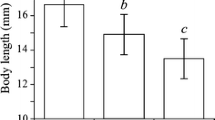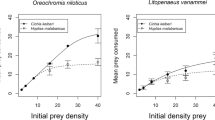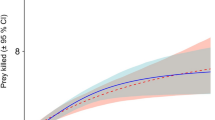Abstract
Intraguild predation (IGP) between invasive and native species can lead to species exclusions or co-existence, dependent on the direction and strength of the interaction. Recently, derivation of ‘functional responses’ has been identified as a means of comparing the community impacts of invasive and native species. Here, we employ a novel use of this functional response methodology to evaluate any IGP asymmetries between the invasive Ponto-Caspian amphipod Echinogammarus ischnus and the North American native Gammarus fasciatus. The direction and magnitude of intraguild predation of adult males on hetero-specific adult females has previously been shown to reverse across a water conductivity gradient. This partially explains field patterns, but does not predict the co-existence of the two species observed in many habitats and locations. Here, we compared intraguild predation by both species on each other’s juveniles in high- and low- conductivity water. G. fasciatus has a higher type II functional response towards E. ischnus juveniles compared to the reciprocal interaction. Conductivity did not influence the predation rate on juveniles of either E. ischnus or G. fasciatus. Thus, the male/female IGP advantage to the native G. fasciatus in low conductivity water is compounded by a juvenile IGP asymmetry, which also counteracts the male/female IGP advantage to E. ischnus in high conductivity waters, helping to explain field patterns of exclusion and co-existence. Thus, complex asymmetries in mutual IGP associated with inherent species differences, environmental modulation, and life-history effects can help us understand and predict the population and community level outcomes of species invasions.

Similar content being viewed by others
References
Arim M, Marquet PA (2004) Intraguild predation: a widespread interaction related to species biology. Ecol Lett 7:557–564
Bollache L, Dick JTA, Farnsworth KD, Montgomery WI (2008) Comparison of the functional responses of invasive and native amphipods. Biol Lett 4:166–169
Dermott R, Witt J, Um EM, Gonzalez M (1998) Distribution of the Ponto-Caspian amphipod Echinogammarus ischnus in the Great Lakes and replacement of native Gammarus fasciatus. J Great Lakes Res 24:442–452
Dick JTA (1996) Post-invasion amphipod communities of Lough Neagh, N. Ireland; influences of habitat selection and differential predation. J Anim Ecol 65:756–767
Dick JTA (2008) Role of behaviour in biological invasions and species distributions; lessons from interactions between the invasive Gammarus pulex and the native G. duebeni (Crustacea: Amphipoda). Contrib Zool 77:91–98
Dick JTA, Platvoet D (1996) Intraguild predation and species exclusions in amphipods: the interaction of behaviour, physiology and environment. Freshw Biol 36:375–383
Dick JTA, Platvoet D (2000) Invading predatory crustacean Dikerogammarus villosus eliminates both native and exotic species. Proc R Soc Lond Ser B 267:977–983
Dick JTA, Montgomery I, Elwood RW (1993) Replacement of the indigenous amphipod Gammarus duebeni celticus by the introduced G. pulex: differential cannibalism and mutual predation. J Anim Ecol 62:79–88
Dick JTA, Platvoet D, Kelly DW (2002) Predatory impact of the freshwater invader, Dikerogammarus villosus (Crustacea: Amphipoda). Can J Fish Aquat Sci 59:1078–1084
Dick JTA, Armstrong M, Clarke HC, Farnsworth KD, Hatcher MJ, Ennis M, Kelly A, Dunn AM (2010) Parasitism may enhance rather than reduce the predatory impact of an invader. Biol Lett. doi:10.1098/rsbl.2010.0171
Hatcher MJ, Dick JTA, Dunn AM (2008) A keystone effect for parasites in intraguild predation? Biol Lett 4:534–537
Holling CS (1959) Some characteristics of simple types of predation and parasitism. Can Entomol 91:385–398
Hunte W, Myers RA (1984) Phototaxis and cannibalism in gammaridean amphipods. Mar Biol 81:75–79
Jokela A, Ricciardi A (2008) Predicting zebra mussel fouling on native mussels from physicochemical variables. Freshw Biol 53:1845–1856
Juliano SA (2001) Nonlinear curve fitting: predation and functional response. In: Gurevitch J, Scheiner M (eds) Design and analysis of ecological experiments. Oxford University Press, New York, pp 178–196
Kelly DW, Dick JTA (2005) Effects of environment and an introduced invertebrate species on the structure of benthic macroinvertebrate species at the catchment level. Archiv für Hydrobiologie 164:69–88
Kelly DW, Dick JTA, Montgomery WI (2002a) The functional role of Gammarus (Crustacea, Amphipoda): shredders, predators, or both? Hydrobiologia 485:199–203
Kelly DW, Dick JTA, Montgomery I (2002b) Predation on mayfly nymph, Baetis rhodani, by native and introduced Gammarus: direct effects and the facilitation of predation by salmonids. Freshw Biol 47:1257–1268
Kelly DW, Dick JTA, Montgomery WI, MacNeil C (2003) Differences in composition of macroinvertebrate communities with invasive and native Gammarus spp. (Crustacea: Amphipoda). Freshw Biol 48:306–315
Kelly DW, Bailey RJE, MacNeil C, Dick JTA, McDonald RA (2006) Invasion by the amphipod Gammarus pulex alters community composition of native freshwater macroinvertebrates. Divers Distrib 12:525–534
Kestrup ÅM, Ricciardi A (2009) Environmental heterogeneity limits the local dominance of an invasive freshwater crustacean. Biol Invasions 11:2095–2105
Krisp H, Maier G (2005) Consumption of macroinvertebrates by invasive and native gammarids: a comparison. J Limnol 64:55–59
Limen H, van Overdijk CDA, MacIsaac HJ (2005) Food partitioning between the amphipods Echinogammarus ischnus, Gammarus fasciatus, and Hyalella azteca as revealed by stable isotopes. J Great Lakes Res 31:97–104
MacNeil C, Dick JTA, Hatcher MJ, Terry RS, Smith JE, Dunn AM (2003) Parasite mediated predation between native and invasive amphipods. Proc Royal Soc Lond B 270:1309–1314
MacNeil C, Prenter J, Briffa M, Fielding NJ, Dick JTA, Riddell GE, Hatcher MJ, Dunn AM (2004) The replacement of a native freshwater amphipod by an invader: roles for environmental degradation and intraguild predation. Can J Fish Aquat Sci 61:1627–1635
Melendre PM, Celada JD, Carral JM, Saez-Royuela M, Aguilera A (2006) Effectiveness of antifungal treatments during artificial incubation of the signal crayfish eggs (Pacifastacus leniusculus Dana. Astacidae). Aquaculture 257:257–265
Palmer ME, Ricciardi A (2004) Physical factors affecting the relative abundance of native and invasive amphipods in the St. Lawrence River. Can J Zool 82:1886–1893
Piscart C, Dick JTA, McCriskin D, MacNeil C (2009) Environmental mediation of intraguild predation between the freshwater invader Gammarus pulex and the native G. duebeni celticus. Biol Invasions 11:2141–2145
Platvoet D, van der Velde G, Dick JTA, Shuqiang L (2009) Flexible omnivory in Dikerogammarus villosus (Sowinsky, 1894) (Amphipoda). Crustaceana 82:703–720
Polis GA, Myers CA, Holt RD (1989) The ecology and evolution of intraguild predation: potential competitors that eat each other. Annu Rev Ecol Syst 20:297–330
Rondeau B (1993) Qualité des eaux du fleuve Saint-Laurent (1985–1990). Tronçon Cornwall-Québec. Environment Canada, Conservation and Protection. Quebec Region, St. Lawrence Centre, Montreal
USGS Water Quality Watch (2009) US Department of the Interior, U.S. Geological Survey, http://waterwatch.usgs.gov/wqwatch/. Page last modified 2 April 2008. Accessed 27 Oct 2009
van Riel MC, van der Velde G, Rajagopal S, Marguillier S, Dehairs F, de Vaate AB (2006) Trophic relationships in the Rhine food web during invasion and after establishment of the Ponto-Caspian invader Dikerogammarus villosus. Hydrobiologia 565:39–58
Vermont Department of Environmental Conservation (2009a) Annual calcium concentrations in Lake Champlain, 1992–2008, Lake Champlain Long-term Water Quality and Biological Monitoring Project. http://www.anr.state.vt.us/dec/waterq/lakes/htm/lp_longterm.htm. Last updated February 2009. Accessed 27 Oct 2009
Vermont Department of Environmental Conservation (2009b) Annual conductivity in Lake Champlain, 1992–2008, Lake Champlain Long-term Water Quality and Biological Monitoring Project. http://www.anr.state.vt.us/dec/waterq/lakes/htm/lp_longterm.htm. Last updated February 2009. Accessed 27 Oct 2009
Acknowledgments
We thank I. Hebert, K. O’Sullivan, N. Bayani, M. Lacharité, A. Hassan, K. Church and R. Kipp for assistance in the field. This work was funded by the Canadian Aquatic Invasive Species Network.
Author information
Authors and Affiliations
Corresponding author
Rights and permissions
About this article
Cite this article
Kestrup, Å.M., Dick, J.T.A. & Ricciardi, A. Interactions between invasive and native crustaceans: differential functional responses of intraguild predators towards juvenile hetero-specifics. Biol Invasions 13, 731–737 (2011). https://doi.org/10.1007/s10530-010-9863-z
Received:
Accepted:
Published:
Issue Date:
DOI: https://doi.org/10.1007/s10530-010-9863-z




